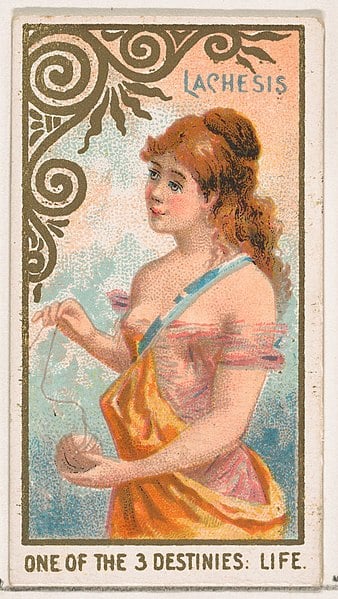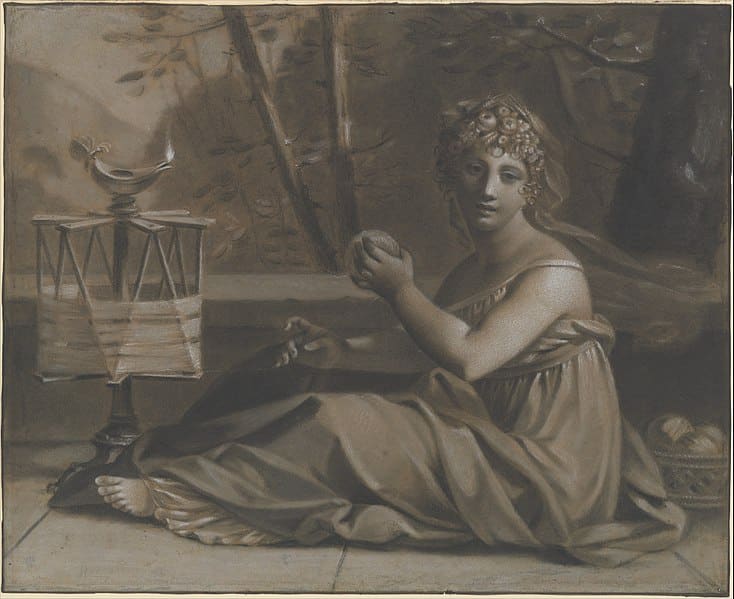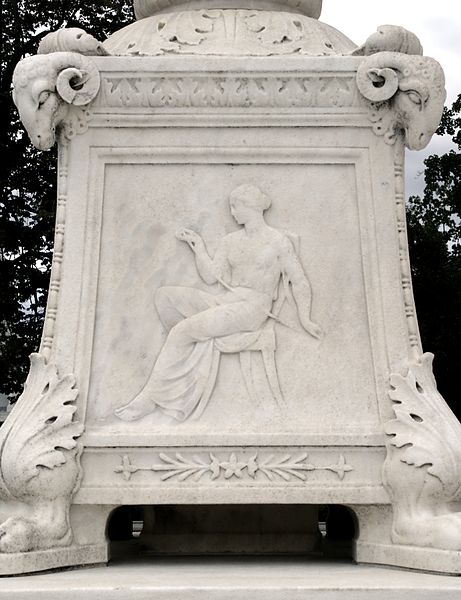Destiny and its inescapability is a concept familiar to most of us. Its manifestation in Greek mythology was through the three Moirai, or Fates. While Clotho spun the thread of life and Atropos cut it, bringing gods and mortals to their deaths, there was a third sister among the two, Lachesis.
Lachesis, the middle sister, was the Moira who measured the thread that Clotho spun. Lachesis had the most fascinating role, as she apportioned how much life each being should be allowed. In reality, she was the one determining the true Destiny of each being.
Lachesis Key Facts
| Parents | Nyx (alone or with Erebus) or possibly Zeus and Themis |
| Partners | None |
| Siblings | Clotho, Atropos |
| Offspring | None |
| Other names | None |
| Roman name | Decima |
| The God of | Measuring the thread of life |
| Symbols | Measuring rod |
Name and Etymology
Lachesis, derived from the Greek word “λαγχάνω” (lanchano), means “to obtain by lot” or “to choose.” This name aptly describes her role in determining the length of the thread of life, symbolizing the duration of a person’s existence. In Roman mythology, her counterpart is Decima, one of the Parcae. While Lachesis might not have as many epithets as some other gods, her name alone carries significant weight, emphasizing the inescapable nature of fate.
The Roman name “Decima” translates to “the Tenth,” a title that might seem arbitrary at first. However, in Roman culture, the tenth day of a newborn’s life was significant; it was when the child would be officially named and accepted into the family. This mirrors Decima’s role in determining the course of one’s life.
While many gods in Greek mythology have various names and titles across different regions and tales, Lachesis remains consistently recognized by this singular name. It’s a testament to the universal respect and slight trepidation the Greeks held for the unyielding force of destiny.

Lachesis Origins
The parentage of the Moirai is not completely agreed upon among the ancient Greek poets and writers. They seem to be born either from the primordial deity Nyx (and possibly Erebus) or by Themis and Zeus. There isn’t a detailed account of Lachesis’ birth or childhood, perhaps because the Fates are ageless entities, existing since the dawn of time. They are Daemones (Spirits) personifying the inescapable destiny of mortals and gods alike. Based on this understanding of them, it makes more sense to me that they are born by the primordial goddess Nyx.
Lachesis and her sisters, Clotho and Atropos, were revered and feared in equal measure. As the Moirai, they were beyond the influence of the Olympian gods, emphasizing the idea that fate is an inescapable force, even for the mightiest deities.
Lachesis, in particular, had the responsibility of measuring the thread of life spun by Clotho. The length she determined would dictate the lifespan of the individual, whether it be short and fleeting or long and prosperous. This role made her an integral figure in the Greek understanding of life and death.
Lachesis Lovers and Relationships
Lachesis, unlike many gods and goddesses in Greek mythology, isn’t known for any romantic entanglements. Her primary focus was her duty alongside her sisters. Their collective role was so paramount that personal relationships or affairs seemed almost trivial in comparison. In the same way, she did not have any offspring. Her essence and purpose revolved around her duties as one of the Fates, and there’s no record of her bearing children, either divine or mortal.
Lachesis Roles And Responsibilities
Lachesis had a singular, yet crucial role in Greek mythology: to measure the thread of life. This duty, while seemingly straightforward, had profound implications. The length of the thread determined not just the lifespan of an individual, but also the quality of their life.
Her responsibilities didn’t end with mere measurement. Lachesis, along with her sisters, ensured that the predetermined fates of mortals and gods alike were carried out without interference. Their collective duty was to maintain the balance and order of the universe.
While Clotho spun the thread and Atropos cut it, Lachesis was the bridge between birth and death, making her an essential figure in the cycle of life.
Depiction And Characteristics
She’s frequently shown holding a measuring rod or a staff, symbolizing her role in determining the length of the thread of life. While the Fates are sometimes portrayed as stern or even foreboding figures, Lachesis, with her measuring tool, embodies the impartiality of destiny.
Lachesis is methodical, precise, and unyielding. Her decisions, once made, are irreversible. While she might seem cold or indifferent, it’s essential to understand that the Fates operate beyond emotions or personal biases. They ensure the natural order of things, making Lachesis a figure of integrity in the Greek pantheon.
Lachesis Powers and Symbol
As one of the Moirai, Lachesis possesses the power to determine the duration of every mortal’s life. This authority is immense, as even the gods of Olympus cannot easily sway the decisions of the Fates. Her power is a testament to the Greek belief in the inevitability of destiny.
Lachesis is closely associated with the measuring rod, a tool she uses to determine the length of the thread of life. This symbol, while simple, carries profound meaning, representing the finite nature of existence and the impartiality of fate.
Myths about Lachesis
Lachesis, as one of the Moirai, is intricately woven into the fabric of many Greek myths. Her role, alongside her sisters, is often pivotal, emphasizing the inescapable nature of fate. Let’s delve into some of the most notable tales that feature Lachesis.
The Birth and Fate of Meleager
The tale of Meleager is a poignant example of the Moirai’s influence. Upon Meleager’s birth, the Fates appeared to his mother, Althaea. They foretold that Meleager’s life would last only as long as a specific log in the hearth remained untouched by flames. Distraught, Althaea quickly removed the log and hid it, hoping to protect her son from his foretold fate.
For many years, Meleager lived, becoming a renowned hero. However, following a dispute over a boar’s hide, Meleager killed his mother’s brothers. In her grief and rage, Althaea threw the hidden log into the fire. As the log was consumed, so too was Meleager’s life, showing that even the actions of a loving mother couldn’t alter the destiny Lachesis had measured.
The Tale of Admetus and Alcestis
King Admetus of Pherae was granted a unique favor by Apollo: he could evade death if someone else willingly died in his place. When the day of his destined death arrived, only his wife, Alcestis, was willing to sacrifice her life for him. As she approached death, Admetus realized the depth of his love for her and the gravity of the sacrifice she was making.
In some versions of the tale, it’s said that the Fates, including Lachesis, were present during this exchange. They stood firm, ensuring that the rules of life and death were upheld. However, due to Heracles’ intervention, Alcestis was eventually returned to the world of the living, but the role of the Fates in this tale underscores the weight and finality of destiny.
Lachesis and the Golden Age of Man
In some myths, Lachesis and her sisters are said to have been particularly active during the Golden Age of Man. This was a time when humans lived in harmony, without the need for labor or strife. It’s said that during this era, the threads of life that Lachesis measured were particularly long, allowing humans to live extended, blissful lives. However, as the ages progressed and mankind became more corrupt, the threads became shorter, symbolizing the decreasing lifespan and increasing hardships of humanity.
Lachesis In Ancient Greek Religion
Lachesis, as one of the Moirai, was revered by the ancient Greeks. While she might not have been as actively worshiped as some Olympian gods, the Fates held a special place in the Greek religious psyche.
There aren’t many temples dedicated solely to Lachesis. However, the Moirai as a collective were honored in various places across Greece. One notable site is the Temple of the Fates in Corinth, where the three sisters were venerated for their integral role in the cosmic order.
Representations Of Lachesis In Art
Lachesis, often alongside her sisters, has been depicted in various forms of art throughout history. From ancient Greek vases showing the Fates at work to Renaissance paintings illustrating their influence over mortal lives, Lachesis with her measuring rod is a recurring figure, symbolizing the inescapable nature of destiny.
Mentions in Ancient Texts
Lachesis, along with her sisters, holds a significant place in ancient Greek literature. Their roles as the determiners of fate made them subjects of reverence and contemplation. Let’s explore some of the most notable mentions of Lachesis in ancient texts.
Homer’s “Iliad” (c. 8th century BC)
Homer, often considered the greatest of ancient Greek epic poets, penned the “Iliad” around the 8th century BC. This epic poem primarily focuses on the Trojan War and the Greek hero Achilles. Within its verses, the Moirai are described as entities even more powerful than the gods. Zeus, the king of the gods, himself admits his inability to save his son Sarpedon from death, emphasizing the unyielding nature of fate.
“Even I cannot save my dear son from his fate; nor can his mother, Thetis, who is far stronger than I am and knows many more spells.”
Hesiod’s “Theogony” (c. 700 BC)
Hesiod, another foundational figure in Greek literature, wrote “Theogony” around 700 BC. This work offers a detailed account of the origins and genealogies of the Greek gods. The Moirai are described as the offspring of Nyx (Night), emphasizing their primordial nature. Hesiod portrays them as essential entities in the cosmic order, ensuring the predetermined fates of mortals and gods alike.
“And Night bore hateful Doom and black Fate and Death.”
Plato’s “Republic” (c. 380 BC)
Plato, the renowned philosopher, makes mention of the Moirai in his philosophical text, “Republic,” written around 380 BC. In this work, which explores justice and the nature of the ideal state, the Fates are invoked to explain the cycle of life and the soul’s journey. Lachesis, in particular, is described as the one who assigns souls to their next life, based on their choices in the present one.
Frequently Asked Questions
Lachesis is responsible for measuring the thread of life, determining the lifespan of an individual.
While not necessarily “more powerful,” the Fates, including Lachesis, operate beyond the influence of the Olympian gods, emphasizing the inescapable nature of destiny.
There aren’t many temples dedicated solely to Lachesis. However, the Moirai as a collective were honored in various places across Greece.
Lachesis isn’t known for any romantic entanglements and has no recorded offspring.
She is closely associated with the measuring rod, symbolizing her role in determining the length of life.
Lachesis is mentioned in various ancient Greek texts, including Homer’s “Iliad” and Hesiod’s “Theogony.”
Featured Image Credit: Pierre-Paul Prud’hon, CC0 1.0, via Wikimedia Commons


